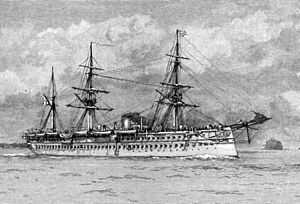HMS Jumna (1866)
 HMS Jumna about 1885 | |
| Career (UK) | |
|---|---|
| Name: | HMS Jumna |
| Ordered: | 1865 |
| Builder: | Palmers Shipbuilding and Iron Company, Hebburn |
| Yard number: | 190 |
| Launched: | 24 September 1866 |
| Fate: |
Became coal hulk C110 in 1893 Sold as hulk Oceanic in July 1922 |
| General characteristics | |
| Class and type: | Euphrates-class troopship |
| Type: | Troopship |
| Displacement: | 6,211 tons, 4,173 tons BM |
| Length: | 360 ft (109.7 m) (overall) |
| Beam: | 49 ft 1.5 in (15.0 m) |
| Depth of hold: | 22 ft 4 in (6.81 m) |
| Installed power: | As built: 4,894 ihp (3,649 kW) From 1873: 3,044 ihp (2,270 kW)[1] |
| Propulsion: |
|
| Sail plan: | Barque-rigged |
| Speed: | 15 kn (28 km/h) |
| Armament: | Three 4-pounder guns |
HMS Jumna was a Euphrates-class troopship launched at Palmers Shipbuilding and Iron Company at Hebburn on 24 September 1866. She was the third vessel of the Royal Navy to carry the name.
Design
Jumna was one of five iron-hulled vessels of the Euphrates class. All five were built to a design of 360 ft overall length by about 49 ft breadth, although Malabar was very slightly smaller than the rest of the class. They had a single screw, a speed of 14 knots, one funnel, a barque-rig sail plan, three 4-pounder guns, and a white painted hull. Her bow was a "ram bow" which projected forward below the waterline.
She was commissioned jointly by the British Admiralty and the Indian government.[2]
History
She spent most of her active career conveying British troops to and from the Indian subcontinent. In 1870 she transported The Connaught Rangers from India back to Britain.
In 1873 her Maudslay, Sons and Field 3-cylinder single-expansion steam engine was modified at Portsmouth by the replacement of one low pressure cylinder with a smaller, high pressure one, giving her a more efficient compound-expansion engine, albeit with less power and a new top speed of 13 knots (24 km/h).[1]
She shipped back the York and Lancaster Regiment to England from Sudan 29 March to April 1884 [3]
Fate
She became the coal hulk C110 in 1893 and was sold as the hulk Oceanic in July 1922.[1][4]
Commanding officers
| From | Until | Captain[5] |
|---|---|---|
| 12 November 1866 | Captain Benjamin Spencer Pickard | |
| 6 June 1870 | Captain Frederick William Richards | |
| 1874 | September 1875 | Captain Hawksworth Fawkes (invalided) |
| 4 October 1875 | 17 October 1877 | Captain John D'Arcy |
| 17 October 1877 | Captain George Parsons | |
| Captain Edmund Church (1881 Census) | ||
| December 1886 | August 1887 | Captain Arthur Dalrymple Fanshawe |
References
- ↑ 1.0 1.1 1.2 Winfield, Rif & Lyon, David (2004). The Sail and Steam Navy List: All the Ships of the Royal Navy 1815–1889. London: Chatham Publishing. ISBN 978-1-86176-032-6. OCLC 52620555.
- ↑ Sir Edward Reed, "The British Navy", Harper's Monthly Magazine (European edition), February 1886
- ↑ "Article based on a Folkstone Advertiser article 8 May 1884 about 65th's history". Wanganui Herald, NZ;. 24 July 1884. Retrieved 22 December 2014.
- ↑ Colledge. Ships of the Royal Navy. p. 83.
- ↑ "HMS Jumna at William Loney RN website". Retrieved 2009-06-23.
- Colledge, J. J.; Warlow, Ben (2006) [1969]. Ships of the Royal Navy: The Complete Record of all Fighting Ships of the Royal Navy (Rev. ed.). London: Chatham Publishing. ISBN 978-1-86176-281-8. OCLC 67375475.
| ||||||||||